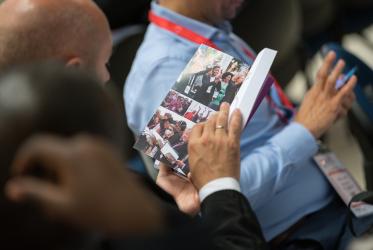Introduction
In the season of Advent, and as we celebrate Christmas, Jesus features in many of our reflections – not so much as a grown man but as a baby, even a baby in the womb. In the readings for this season and in the images we look at (whether Christmas cards or icons), we do not encounter the adult Jesus who speaks and teaches, but the baby Jesus, or the child Jesus, or the expected Jesus. The Jesus of this season is not one who speaks words of love himself or who commands people to love, or even one who does loving things. He is first of all a Jesus who receives love, who is dependent upon the love of others, and who embodies the love of God before he can enact it or speak of it. In this season, in the Christ who receives love, we see the very depth of God’s love as the one who loves us so much that he becomes vulnerable, becomes one who “empties himself,” taking the form of a child among us. We discover, in the stories of this season of our faith, that love cannot be only an act of power, but must also be an act of vulnerability. The Christ we meet in the stories of Christmas is not active and vocal but passive and inarticulate, the one receiving love. It is this God, the God who longs for our love, and who draws love forth from us, who teaches us the mysteries of love most fully.
Bible passages: Luke 2:1-7; Luke 2:25-35; Luke 2:41-51
Luke 2:1-7
In those days a decree went out from Emperor Augustus that all the world should be registered. This was the first registration and was taken while Quirinius was governor of Syria. All went to their own towns to be registered. Joseph also went from the town of Nazareth in Galilee to Judea, to the city of David called Bethlehem, because he was descended from the house and family of David. He went to be registered with Mary, to whom he was engaged and who was expecting a child. While they were there, the time came for her to deliver her child. And she gave birth to her firstborn son and wrapped him in bands of cloth, and laid him in a manger, because there was no place for them in the inn.
Luke 2:25-35
Now there was a man in Jerusalem whose name was Simeon; this man was righteous and devout, looking forward to the consolation of Israel, and the Holy Spirit rested on him. It had been revealed to him by the Holy Spirit that he would not see death before he had seen the Lord’s Messiah. Guided by the Spirit, Simeon came into the temple; and when the parents brought in the child Jesus, to do for him what was customary under the law, Simeon took him in his arms and praised God, saying,
“Master, now you are dismissing your servant in peace,
according to your word;
for my eyes have seen your salvation,
which you have prepared in the presence of all peoples,
a light for revelation to the Gentiles
and for glory to your people Israel.”
And the child’s father and mother were amazed at what was being said about him. Then Simeon blessed them and said to his mother Mary, “This child is destined for the falling and the rising of many in Israel, and to be a sign that will be opposed so that the inner thoughts of many will be revealed—and a sword will pierce your own soul too.”
Luke 2:41-51
Now every year his parents went to Jerusalem for the festival of the Passover. And when he was twelve years old, they went up as usual for the festival. When the festival was ended and they started to return, the boy Jesus stayed behind in Jerusalem, but his parents did not know it. Assuming that he was in the group of travellers, they went a day’s journey. Then they started to look for him among their relatives and friends. When they did not find him, they returned to Jerusalem to search for him. After three days they found him in the temple, sitting among the teachers, listening to them and asking them questions. And all who heard him were amazed at his understanding and his answers. When his parents saw him they were astonished; and his mother said to him, “Child, why have you treated us like this? Look, your father and I have been searching for you in great anxiety.” He said to them, “Why were you searching for me? Did you not know that I must be in my Father’s house?” But they did not understand what he said to them. Then he went down with them and came to Nazareth, and was obedient to them. His mother treasured all these things in her heart.
Reflection
In the Christian tradition, we are very familiar with the idea that Mary taught the child Jesus, as any mother might teach her child. There is a strong tradition in Western Christianity, for example, of paintings in which Mary is depicted teaching her child how to read – particularly to read the scriptures. We can also find paintings of Joseph teaching Jesus the skills of a carpenter in the workshop. Some of this may well be fanciful, but it must be true, in some ways at least, that Mary, and Joseph, too, perhaps, taught Jesus something about love. Here we meet the kind of profound theological paradox that is always part of the mystery of the incarnation: that the one who is the source of all love became human in Jesus Christ and so became not only the source of love, but the object of love, too. And indeed, perhaps it is profoundly true that none of us can ever only be the subject of love (the active one), for true love can only really be discovered when we are its object. Love is learned as we are loved. In Jesus, we see the mystery of the God who is love opening himself up to receive love from others and indeed being dependent on such love.
In the Bible passages from Luke’s account of Jesus’ birth we see, in small but powerful glimpses, how Jesus was loved by Mary. At Christmastime we make much of these glimpses and we draw out, by developing them, how the Christ child was the object of human love.
We see Mary giving birth to her firstborn, wrapping him in bands of cloth, and laying him in a manger. Any mother who has swaddled a child will know how much such wrapping brings comfort to the newborn who has left the warmth and cradle of the womb. This is an act of love, to make sure the child is cradled, comforted, and warmed. Here we see Mary doing what countless loving mothers have done. And though, or perhaps precisely because, this is such a common act of love, we are moved by it.
Later in the story, we see Mary and Joseph taking their child to the temple “to do for him what was customary under the law,” and we might sense their pride in being new parents. They were even more amazed when the old man, Simeon, in the temple began to speak about their child as a “light for revelation to the Gentiles and the glory of your people Israel.” And then Simeon warns that there will be suffering to come; he confides to Mary that “a sword will pierce your own soul too.” Mary may wonder at her child as any mother would, but Simeon knows that her love will also bring her pain, that love is costly, that love makes her profoundly vulnerable. Since we know how the story will unfold, we cannot help but think of the Mary who will stand at the foot of the cross, and we bring to mind the many moving depictions of Mary holding in her arms, not a living baby, but the dead Christ, taken down from the cross. We know how love is often to be pitied for the pain it brings. Love makes us vulnerable. This is the love that Jesus experienced as a child from his mother and that he also lived out himself.
In the story about the child Jesus becoming lost, we experience the pain that love meant for Mary. When she is reunited with her son, she says, “Child, why have you treated us like this? Look, your father and I have been searching for you in great anxiety.” And as the story ends, we read that Mary “treasured all these things in her heart.” This is a loving mother; these are loving parents for whom, as many will testify, life is always more vulnerable because it is so bound up with the wellbeing of your child.
Mary may or may not have taught her child to read, but she surely taught him something about how to love. All of us learn first about love from our parents or from those who bring us up. Whether we can articulate them or not, the lessons about love that we learn from our parents are those that stay with us as we become our adult selves. We all know that the people who receive all-embracing and unconditional love in their childhood are those who tend to grow to be well adjusted and confident adults, equipped and ready to be loving and generous in their own relationships. Love is not something we can easily decide to exercise or enact entirely for ourselves, but it is something we all need to receive before we can give it – this is the nature of love.
The Presbyterian novelist and theologian Frederick Buechner has written movingly about how love for his grandchildren began:
That day on the staircase when I met my first grandchild for the first time, what I saw with the eyes of my head was a very small boy with silvery gold hair and eyes the color of blue denim coming down toward me in his mother’s arms. What I saw with the eyes of my heart was a life that without a moment’s hesitation I would have given my life for. (The Eyes of the Heart, 1999, 165–66)
Buechner writes, more recently, that just as he once learned so much about love from his grandparents, so now he learns about love from his six grandchildren, who love him without reserve. Jesus was part of a human family and learned there the lessons of love: its power, passion, and vulnerability. He later taught parables about love, spoke a “new commandment” to love one another, described the two most important commandments as “love God and love your neighbour,” loved his disciples as friends (not servants), wept for the death of Lazarus whom he loved, and poured out his love for the world on the cross. All this love, the love of Christ, flows from the heart of God but was also shaped by the love Jesus received from his mother, his family, and his friends. Jesus, as the Word become flesh, did not only speak of love as though from a distance as one untouched; he himself knew the realities of being loved and of loving. Divine love was cradled in human love. And so, in turn, our human love can be blessed with divine grace.
Questions for further reflection
- How did you learn that you were loved?
- What things in your life make it hard for you to love?
- What do you see that is distinctive about the love that Jesus spoke about?
Prayer
Lord Jesus Christ, Son of God,
who knew the love of Mary
and the vulnerability of childhood,
we kneel at your crib
as we wait beneath your cross,
to see the power of love displayed
from arms reaching out to the world.
Give to us those who will love us
with a Christ-like love,
that we too may love in turn
as you invite us,
this day and always, Amen.
Song: Mary, Did You Know?
About the author
Rev. Dr Susan Durber is a minister of the United Reformed Church in the UK, serving a congregation in the Southwest of England. She has published a book and articles on the parables of Jesus, books on preaching, and collections of prayers. As a former theology advisor for Christian Aid, she has published on poverty, on gender, and on climate change. She is the moderator of the Faith and Order Commission of the World Council of Churches.






